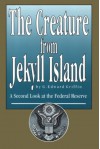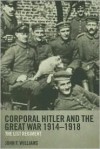Currently reading
Gabriela, Cravo e Canela
Progress:
157/358 pages
Seven Pillars of Wisdom: A Triumph (The Authorized Doubleday/Doran Edition)
Progress:
189/672 pages
The Creature from Jekyll Island: A Second Look at the Federal Reserve
Progress:
41/608 pages
Peter the Great
Progress:
472/934 pages
Under the Loving Care of the Fatherly Leader: North Korea and the Kim Dynasty
A Time for Trumpets: The Untold Story of the Battle of the Bulge
Progress:
191/712 pages
The German Army 1933-1945
Progress:
198/598 pages
Corporal Hitler and the Great War 1914-1918: The List Regiment
Progress:
22/238 pages
LIVING A LIFETIME IN 3 HOURS

As someone with a special fondness for Second World War adventure stories, I came to "THREE HOURS IN PARIS" with a lot of high expectations. Indeed, it was about 2 years ago, when I went to see Cara Black speak at a local bookstore about one of her Aimée Leduc novels, she had mentioned to the audience that she was at work on a novel that would be taking place in Paris during the Second World War. That was enough to pique my interest.
So, I began reading "THREE HOURS IN PARIS" eagerly anticipating reading a novel that would enthrall me from start to finish. Well, it wasn't quite like that. I was 35 pages into the novel feeling underwhelmed by what I had read. In fact, what I was reading struck me as shoddy and amateurish, something a reader would expect to find from a first-time novelist, not a practiced and celebrated writer. There is a scene in which one of the main characters in the novel, Kate Rees, is working near a military installation at Hoy in the Orkney Islands (near Scotland) when the installation comes under attack by the German Luftwaffe (air force). Two sentences that helped to describe the ensuing action immediately stood out before my eyes as someone who is a longtime aviation enthusiast. The first sentence is "A propeller plane droned out of the clouds, followed by a second, then a third one." What is THAT supposed to mean? I didn't find that to be a particularly descriptive sentence that would have made the action more compelling and real to me. What kind of aircraft is a propeller plane?! Frankly, that was an awkward sentence and should have been re-worked.
And as for the second sentence, that rankled me because it makes absolutely no sense at all! Well, as a way of proving my point, I'll also include the preceding sentence: "The Luftwaffe were taking another pass now that the clouds had cleared. Only two this time, their swastikas glinting on the fuselage." SWASTIKAS GLINTING ON THE FUSELAGE?! As someone who has read about and studied Second World War aviation since I was a preteen, I know for a fact that Luftwaffe planes bore the swastika on the tail unit, NOT THE FUSELAGE. (The fuselage is the main body of an airplane, distinct from the wings and the tail unit.) Clearly, the author failed to take account of that fact.
Kate, feeling bereaved and bereft after losing her husband and baby daughter during the first year of the war, accepts the offer made by a mysterious and officious gentleman --- who had been made aware of her prowess as a sharpshooter --- to come to London and join the ranks of Section D in British intelligence (i.e., the Secret Intelligence Service or SIS = MI-6).
The time is mid-June 1940. Paris has been declared an 'open city' and the Germans have marched in and occupied it. The British Expeditionary Force (BEF), along with a few scattered French army units, has managed to escape to Britain from the French port of Dunkirk. France is on the brink of total defeat. Kate is hastily trained to undertake a special mission to Paris, where her skills as a sharpshooter would prove to be valuable. She is parachuted into France on the night of June 22, 1940 (which is also the day that France has signed an armistice with Nazi Germany), landing in a non-descript area a short distance from Paris.
From the point Kate arrives in Paris, the pace in the novel quickens. The drama becomes compelling and that is what saved the novel for me. Yet, "THREE HOURS IN PARIS" is not in the class of a Frederick Forsyth, Alan Furst or a John le Carré espionage/action thriller. If Cara Black decides to write another Second World War novel set in France, I hope she will craft a tighter story and show greater care in conveying some historical details.
So, I began reading "THREE HOURS IN PARIS" eagerly anticipating reading a novel that would enthrall me from start to finish. Well, it wasn't quite like that. I was 35 pages into the novel feeling underwhelmed by what I had read. In fact, what I was reading struck me as shoddy and amateurish, something a reader would expect to find from a first-time novelist, not a practiced and celebrated writer. There is a scene in which one of the main characters in the novel, Kate Rees, is working near a military installation at Hoy in the Orkney Islands (near Scotland) when the installation comes under attack by the German Luftwaffe (air force). Two sentences that helped to describe the ensuing action immediately stood out before my eyes as someone who is a longtime aviation enthusiast. The first sentence is "A propeller plane droned out of the clouds, followed by a second, then a third one." What is THAT supposed to mean? I didn't find that to be a particularly descriptive sentence that would have made the action more compelling and real to me. What kind of aircraft is a propeller plane?! Frankly, that was an awkward sentence and should have been re-worked.
And as for the second sentence, that rankled me because it makes absolutely no sense at all! Well, as a way of proving my point, I'll also include the preceding sentence: "The Luftwaffe were taking another pass now that the clouds had cleared. Only two this time, their swastikas glinting on the fuselage." SWASTIKAS GLINTING ON THE FUSELAGE?! As someone who has read about and studied Second World War aviation since I was a preteen, I know for a fact that Luftwaffe planes bore the swastika on the tail unit, NOT THE FUSELAGE. (The fuselage is the main body of an airplane, distinct from the wings and the tail unit.) Clearly, the author failed to take account of that fact.
Kate, feeling bereaved and bereft after losing her husband and baby daughter during the first year of the war, accepts the offer made by a mysterious and officious gentleman --- who had been made aware of her prowess as a sharpshooter --- to come to London and join the ranks of Section D in British intelligence (i.e., the Secret Intelligence Service or SIS = MI-6).
The time is mid-June 1940. Paris has been declared an 'open city' and the Germans have marched in and occupied it. The British Expeditionary Force (BEF), along with a few scattered French army units, has managed to escape to Britain from the French port of Dunkirk. France is on the brink of total defeat. Kate is hastily trained to undertake a special mission to Paris, where her skills as a sharpshooter would prove to be valuable. She is parachuted into France on the night of June 22, 1940 (which is also the day that France has signed an armistice with Nazi Germany), landing in a non-descript area a short distance from Paris.
From the point Kate arrives in Paris, the pace in the novel quickens. The drama becomes compelling and that is what saved the novel for me. Yet, "THREE HOURS IN PARIS" is not in the class of a Frederick Forsyth, Alan Furst or a John le Carré espionage/action thriller. If Cara Black decides to write another Second World War novel set in France, I hope she will craft a tighter story and show greater care in conveying some historical details.













